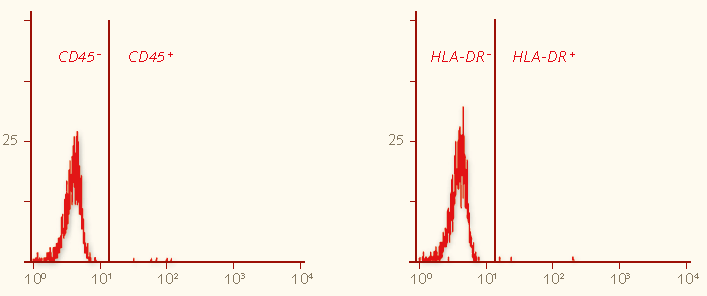Mesenchymal Stem Cell Characterization
Mesenchymal stem cells (MSCs) are fibroblast-like multipotent adult stem cells derived from multiple tissue (including bone marrow, adipose tissue, umbilical cord, and dental pulp) with the capacity to self-renew. Historically, researchers have isolated these stem cells using various methods and a standardized criteria for proper MSC characterization was proposed by the International Society for Cellular Therapy (ISCT) to aide in cell culture consistency. According to the guidelines, MSCS must 1) be plastic adherent when kept under standard culture conditions 2) express the proper positive and negative MSC markers and 3) retain a multipotent phenotype with the ability to differentiate into adipocytes, osteoblasts and chondrocytes under the standard differentiation conditions. All of PromoCell’s human mesenchymal stem cell lines are quality controlled tested for all three ISCT criteria on each lot manufactured to guarantee cell identity and performance.

Figure 1.Minimum ISCT criteria to indentify human MSCs.

Positive MSC Markers

Negative MSC Markers

Figure 2. Flow cytometry analysis of PromoCell human mesenchymal stem cells isolated from bone-marrow. Histograms of CD73, CD90 and CD105 positive expression and CD14, CD19, CD45, and HLA-DR negative expression.
Mesenchymal Stem Cell Self-Renewal

Figure 3. Growth performance of bone marrow derived hMSCs on fibronectin coated plastic. MSCs cultured in the serum-free/xeno-free PromoCell Growth Medium DXF over 7 passages maintain a stable growth rate of less than 30 hr/doublings.
Mesenchymal Stem Cell Differentiation

Figure 4. Differentiation of multipotent bone-marrow derived hMSCs into adipocytes, chondrocytes and osteocytes. A) Lipid vesicle accumilation in adipocytes exhibit extensive intracellular lipid vacoule formation. B) Alcian Blue staining of chondrocytes and cartillage extracellular matrix. C) Alizarin Red S staining of calcium deposits in mineralized osteoblasts.
Conclusions
Isolation of human MSCs using PromoCell’s defined serum-free media yields a uniform, well-defined MSC population in agreement with the expression profiles proposed by the ISCT. The stable growth performance and expansion over multiple passages demonstrates the self-renewing capabilities on the cells. Multipotency has been demonstrated by the trilineage differentiation of MSCs into adipogenic, osteogenic and chondrogenic lineages. The MSC isolation method and culture conditions play a critical role in obtaining a well-defined mesenchymal stem cell population that agrees with the guidelines outlined by the ISCT. Standardizing MSC characterization and culture conditions ensures the generation of reproducible results from lab to lab.
Materials
To continue reading please sign in or create an account.
Don't Have An Account?